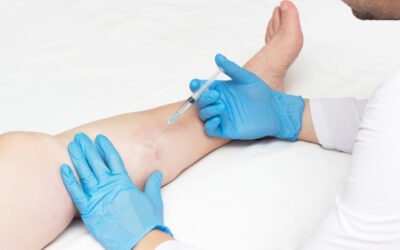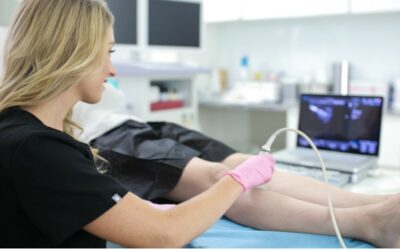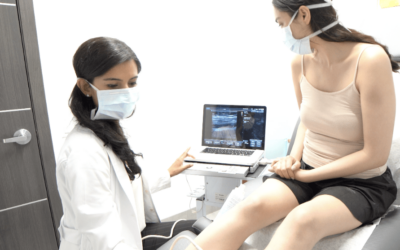What Happens During Varicose Vein Treatment Near Me in Texas?
03/10/2020
Varicose Vein Treatment Near Me in Texas
“What happens during varicose vein treatment near me in Texas?”
At Vein Treatment Clinic Texas, we’ve been receiving a lot of similar questions. We’ve come to realize that most people don’t have a strong understanding of what minimally invasive varicose vein treatments entail.
Some even believe varicose vein treatments are surgical and dangerous — a completely misinformed belief based on information that’s decades old. The truth is, minimally invasive varicose vein treatments include sclerotherapy, endovenous laser ablation, and other safe and painless procedures.
The following is a step-by-step overview of what you can expect from varicose vein treatment near me in Texas.
- Step 1: Vein doctors and staff examine vein problems and leg pain.
- Step 2: Vein doctors and staff diagnose vein disease through vascular imaging tests.
- Step 3: Vein doctors and staff discuss minimally invasive treatment options and insurance plans.
- Step 4: Vein clinics perform minimally invasive varicose vein treatments.
- Step 5: Vein clinics include sclerotherapy to remove spider veins.
- Step 6: Vein doctors and staff discuss leg pain after-care.
In this article, the vein doctors in Vein Treatment Clinic’s Texas office want to set the record straight. The following is a detailed discussion of every step involved in the varicose vein treatment process.
Step 1: Vein doctors and staff examine vein problems and leg pain.
As with most vein problems and issues, the first step is a general examination and diagnosis. During your initial consultation, the vein doctor will examine your legs for spider veins and varicose veins. The vein doctor will also ask you to describe all of your symptoms and vein problems.
Your vein doctor will try to identify if you have vein disease. Also called chronic venous insufficiency, vein disease is a circulatory disorder in which your vein valves collapse, which causes blood to flow backward, accumulating in your leg veins.
Vein disease is dangerous but extremely under-diagnosed because its initial warning signs may get attributed to aging. In fact, in recent weeks, we’ve also had patients misattribute the signs and symptoms of vein disease to COVID-19 symptoms.
Some of the early warning signs and symptoms of vein disease include frequent leg cramps, restless legs syndrome, leg pain, leg heaviness, and the formation of spider veins. Furthermore, these symptoms get worse at the end of the day or after long periods of inactivity. These are signs and symptoms of vein disease — they’re not COVID-19 symptoms.
Step 2: Vein doctors and staff diagnose vein disease through vascular imaging tests.
After examining your legs and hands for vein problems, the vein doctors and staff will use vascular imaging to identify vein disease with certainty. Duplex Ultrasound is a vascular imaging test that allows vein doctors and staff to visualize the blood flow in your leg veins.
As mentioned previously, venous insufficiency is a condition in which your blood flows backward to accumulate in leg veins due to faulty vein valves. As such, the vein doctors will see evidence of venous reflux on the computer screen, thus diagnosing the root cause of varicose veins and spider veins.
Step 3: Vein doctors and staff discuss minimally invasive treatment options and insurance plans.
Once the vein doctors diagnose vein disease, they will discuss your minimally invasive treatment options and insurance plans.
If you have vein disease, the vein doctors will recommend minimally invasive varicose vein treatments, including radiofrequency ablation, endovenous laser ablation, or VenaSeal. If you don’t have vein disease — only spider veins — the minimally invasive treatment will include sclerotherapy.
Insurance plans only cover medically necessary procedures. As such, your insurance plans may cover radiofrequency ablation and endovenous laser ablation, but not VenaSeal or sclerotherapy.
Your vein doctors and staff will examine your insurance plans to advise you on the correct minimally invasive treatment path.

BOOK AN APPOINTMENT
Vein Treatments are covered by most major medical insurances, including Medicare. Verify your coverage for FREE today!
Step 4: Vein clinics perform minimally invasive varicose vein treatments.
Radiofrequency ablation, endovenous laser ablation, and VenaSeal are the best minimally invasive varicose vein treatments.
During these vein procedures, the vein doctors and staff use thermal energy, laser energy, or medical adhesives (respectively) to collapse or seal the diseased saphenous vein. Once the diseased vein is removed, the accumulated blood reroutes to healthier veins, restoring smooth blood circulation.
Step 5: Vein clinics include sclerotherapy to remove spider veins.
Most vein clinics also include sclerotherapy after the varicose vein treatment to remove visible spider veins.
During sclerotherapy, the vein doctor injects a medicine called sclerosant into the spider veins. The sclerosant solution fuses the spider veins’ walls, shutting them down. The accumulated blood reroutes to healthier veins. The spider veins eventually harden into scar tissues and get absorbed by the body, fading away from the skin.
Step 6: Vein doctors and staff discuss leg pain after-care.
Minimally invasive varicose vein treatments conclude within an hour with no hospitalization or downtime. After the minimally invasive procedures, your vein doctors and staff will discuss your leg pain after-care.
You will have to wear compression stockings for a few days or weeks to manage the leg pain and facilitate smooth blood circulation. You’ll also be advised to walk for at least an hour every day, but avoid heavy exercises like weightlifting. You can resume most of your daily activities immediately.
Consult our Vein Clinics
Vein Treatment Clinic has some of the country’s foremost vein doctors specializing in vascular imaging, cosmetic surgery, and minimally invasive varicose vein treatments. Our Houston vein clinic is located in Uptown Houston, just a short walk from The Galleria. For more information, please schedule your varicose vein treatment at our vein clinics today.
Meet Our Houston
Vein Doctor

Calvin Jung MD
Spider Vein and Varicose Vein Doctor
Dr. Jung focuses on spider and varicose vein removal by implementing minimally-invasive vein treatments such as sclerotharpy, radiofrequency ablation, clarivein & VenaSeal.
WHAT TO EXPECT IN OUR
Texas Vein Center
contact us today
Call us
Book online
Visit our Book Appointment page and instantly request an appointment at a Texas vein center near you. We offer Free Insurance Verification before your appointment.
Get directions
Learn how to easily get to the Texas vein center nearest to you.
FEATURED POSTS BY VEIN DOCTORS
What Does a Vein Clinic Do? Top Vein-Related FAQs, Answered
What Does a Vein Clinic Do? Top Vein-Related FAQs, AnsweredApril 24, 2022What does a vein clinic do?A vein clinic is a medical center responsible for the diagnosis and treatment of vein-related conditions, such as spider veins and varicose veins. As such, vein clinics...
What is a Varicose Vein Specialist Called? We Answer Your Vein Treatment Questions
What is a Varicose Vein Specialist Called? We Answer Your Vein Treatment QuestionsApril 23, 2022What is a varicose vein specialist called?The official terminology for a varicose vein specialist is a “phlebologist.” The name is derived from “phlebology,” the branch of...
Are Varicose Vein Treatments Covered by Insurance? And Other Vein-Related FAQs
Are Varicose Vein Treatments Covered by Insurance? And Other Vein-Related FAQsApril 23, 2022Are varicose vein treatments covered by insurance?Generally speaking, insurance policies cover medical treatments that are deemed “medically necessary.” As such, to understand...
What Kind of Doctor Specializes in Veins? We Answer Your Top Vein Questions
What Kind of Doctor Specializes in Veins? We Answer Your Top Vein QuestionsApril 23, 2021What kind of doctor specializes in veins?Vein doctors, also known as phlebologists, are the medical professionals who deal with vascular health, including the diagnosis and...



